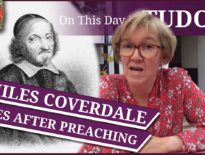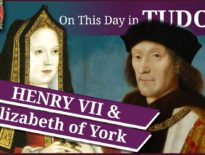On this day in Tudor history, 19th January 1601, Henry Herbert, 2nd Earl of Pembroke, died at Wilton, the family home near Salisbury.
Who was Henry Herbert?
Let me tell you about this interesting Tudor man in today's talk.
You can see photos of his armour at https://www.metmuseum.org/art/collection/search/23937
Also on this day in Tudor history, 19th January 1547, poet, courtier and soldier, Henry Howard, Earl of Surrey and son of Thomas Howard, 3rd Duke of Norfolk, was executed by beheading on Tower Hill. Find out more in my video from last year:
Also on this day in history:
- 1561 – Death of Sir Edward Carne, administrator and diplomat, in Rome. Carne carried out diplomatic missions for Henry VIII, was a Royal Commissioner during the dissolution of the monasteries, negotiated the marriage of Henry VIII and Anne of Cleves, and was Mary I's English ambassador to Rome.
- 1636 – Death of Marcus Gheeraerts, painter, in London. He is known for his “Ditchley” portrait of Elizabeth I.
Transcript:
On this day in Tudor history, 19th January 1601, Henry Herbert, 2nd Earl of Pembroke, died at Wilton, the family home near Salisbury. He had been suffering from ill health for about five years.
Let me give you a few facts about this Tudor nobleman…
• Henry Herbert was born in around 1538 and was the eldest son and heir of William Herbert, 1st Earl of Pembroke, and his wife, Anne Parr, who was the sister of Queen Catherine Parr.
• He was married three times: On 25th May 1553, at the same ceremony that Lady Jane Grey married Lord Guildford Dudley, Herbert married Jane’s sister, Lady Catherine Grey. It wasn’t consummated and just a year later, in 1554, following the fall of Lady Jane Grey, it was annulled. Herbert married Catherine Talbot, daughter of George Talbot, Earl of Shrewsbury, in 1563, but she died childless in 1576. In April 1577, Herbert married Mary Sidney, daughter of Sir Henry Sidney and sister of poets Sir Philip Sidney and Sir Robert Sidney. The couple had three surviving children: William, Philip and Anne. Mary was a literary patron and their home of Wilton was described as “like a college”.
• Herbert was made a Knight of the Bath as part of Mary I’s coronation celebrations in 1553 and after Mary married Philip of Spain he was made one of the king’s gentlemen of the bedchamber.
• He served the queen in France in 1557, being present at the Siege of St Quentin with his father.
• He became Earl of Pembroke on his father’s death in 1570 and also became Lord Lieutenant of Wiltshire.
• In 1586, he succeeded his father-in-law, Sir Henry Sidney, as Lord President of the Council in the Welsh Marches.
• Herbert could speak Welsh.
• He could be rather rash. A messenger once refused to deliver a letter from Herbert to Queen Elizabeth I because “he found it would be his Lord’s overthrow to have so passionate a letter delivered unto the queen.”
• He was a good friend of Robert Dudley, Earl of Leicester, and patron of the theatre company, Pembroke's Men.
• In the 1590s, he had a feud with Robert Devereux, Earl of Essex, and his rival faction in Wales.
• He died at Wilton on this day in 1601 and although John Chamberlain wrote of him “leaving his lady as bare as he could and bestowing all on the young lord, even to her jewels”, his biographer Penry Williams points out that Herbert’s will shows that he left Mary substantial rents, as well as jewels and plate to the value of 3000 marks.
• Herbert was laid to rest in Salisbury Cathedral.
• A suit of armour made for Herbert by the royal workshops at Greenwich in around 1585/6 is in the collection of the Met Museum in New York. It is decorated with his coat of arms and also the Order of the Garter, which he was awarded in 1574.



Leave a Reply